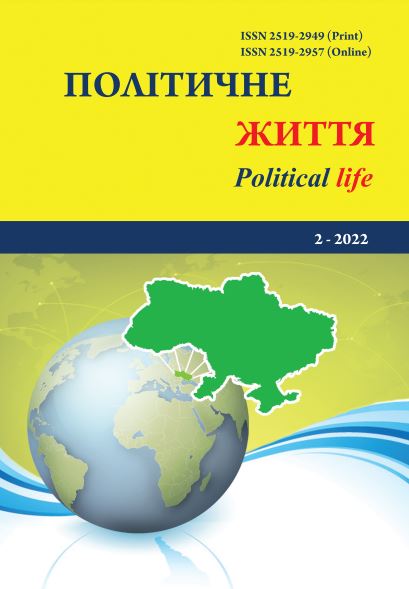World models of post-conflict territory governance. Experience for Ukraine
DOI:
https://doi.org/10.31558/2519-2949.2022.2.10Keywords:
post-conflict territory; public policy models; institutions of public policy; political system; temporarily uncontrolled territoryAbstract
Reintegration planning and post-conflict management policies largely depend on the form of conflict resolution. At present, it is impossible to predict the form of the end of the Russian-Ukrainian war, so any policy-making activity in this area can only serve as a theoretical basis for the processes that will take place in practice.
The article examines the models of post-conflict management within the management process, which is localized within the territory affected by the armed conflict, is considered a resource by various political actors, requires institutional order and overcoming the consequences of the conflict.
Strategies for the influence of international and national actors on the management of post-conflict territories have been identified. It is determined that in the post-conflict territories international organizations perform their statutory functions, thus justifying their functioning in the crisis of the system of international law and international relations.
Based on the "ideal types" of models of international and national governance, the models of postconflict territory management that can be implemented in Ukraine under certain scenarios are considered. The analysis of four models provided an opportunity to make some generalizations: the Bosnian model – peace at the cost of limiting sovereignty and increasing internal contradictions. The implementation of the Croatian model will lead to serious human, material and image losses in Ukraine. At the same time, the application of the Pakistani model to the temporarily occupied territories will threaten to further fragment Ukraine. The German model is focused on creating favorable conditions in the distant future. According to the criteria of control over the management of post-conflict territory and the ability to exercise this control, the best scenario for the management of deoccupied territories is to develop its own adaptive model that will demonstrate its effectiveness in achieving such a goal as establishing a peaceful, sovereign and democratic development of Ukrainian territories. research remains out of Ukraine’s control.
References
Кістерський Л.Л. Формування сучасної Європи: стримування та розвиток. Економіка України, 2015. № 4(641). С. 19-27.
Конвенція про закони і звичаї суходільної війни (IV Гаазька конвенція) URL: http://zakon3.rada.gov.ua/laws/show/995_222
Михальська В. В. Політика управління постконфліктними територіями. Сучасне суспільство: політичні науки, соціологічні науки, культурологічні науки: збірник наукових праць, 2017. Вип. 1(13). С. 131-144.
Михальська В. В. Постконфліктні управлінські практики в економічній політиці. Політичне життя, 2018. № 2. С. 55-60
Музаффарлі Н., Ісмаїлов Еге. До питання відновлення постконфліктних територій. Кавказ та Глобалізація. 2009. № 3 (2-3). С. 7-28.
Judt T. Postwar: A History of Europe Since 1945. NY: The Penguin Press, 2005. 878 p.
PACE Doc. 14139 (Report). Legal remedies for human rights violations on the Ukrainian territories outside the control of the Ukrainian authorities. URL: http://assembly.coe.int/nw/xml/XRef/XrefDocDetails-EN.asp?fileid= 23007&lang=2

